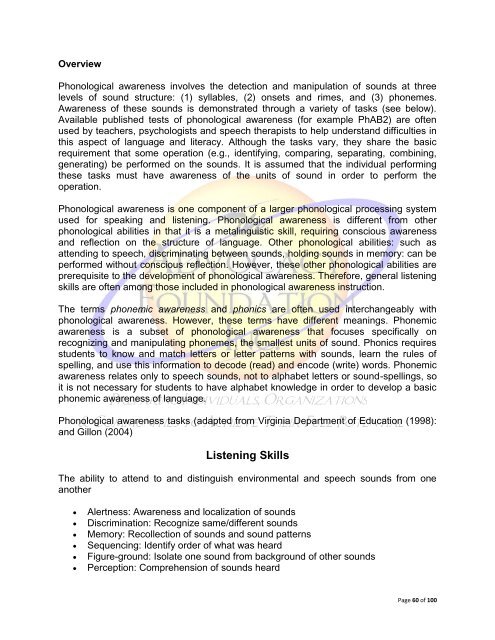Overcoming Dyslexia
Overcoming Dyslexia
Overcoming Dyslexia
You also want an ePaper? Increase the reach of your titles
YUMPU automatically turns print PDFs into web optimized ePapers that Google loves.
Overview<br />
Phonological awareness involves the detection and manipulation of sounds at three<br />
levels of sound structure: (1) syllables, (2) onsets and rimes, and (3) phonemes.<br />
Awareness of these sounds is demonstrated through a variety of tasks (see below).<br />
Available published tests of phonological awareness (for example PhAB2) are often<br />
used by teachers, psychologists and speech therapists to help understand difficulties in<br />
this aspect of language and literacy. Although the tasks vary, they share the basic<br />
requirement that some operation (e.g., identifying, comparing, separating, combining,<br />
generating) be performed on the sounds. It is assumed that the individual performing<br />
these tasks must have awareness of the units of sound in order to perform the<br />
operation.<br />
Phonological awareness is one component of a larger phonological processing system<br />
used for speaking and listening. Phonological awareness is different from other<br />
phonological abilities in that it is a metalinguistic skill, requiring conscious awareness<br />
and reflection on the structure of language. Other phonological abilities: such as<br />
attending to speech, discriminating between sounds, holding sounds in memory: can be<br />
performed without conscious reflection. However, these other phonological abilities are<br />
prerequisite to the development of phonological awareness. Therefore, general listening<br />
skills are often among those included in phonological awareness instruction.<br />
The terms phonemic awareness and phonics are often used interchangeably with<br />
phonological awareness. However, these terms have different meanings. Phonemic<br />
awareness is a subset of phonological awareness that focuses specifically on<br />
recognizing and manipulating phonemes, the smallest units of sound. Phonics requires<br />
students to know and match letters or letter patterns with sounds, learn the rules of<br />
spelling, and use this information to decode (read) and encode (write) words. Phonemic<br />
awareness relates only to speech sounds, not to alphabet letters or sound-spellings, so<br />
it is not necessary for students to have alphabet knowledge in order to develop a basic<br />
phonemic awareness of language.<br />
Phonological awareness tasks (adapted from Virginia Department of Education (1998):<br />
and Gillon (2004)<br />
Listening Skills<br />
The ability to attend to and distinguish environmental and speech sounds from one<br />
another<br />
<br />
<br />
<br />
<br />
<br />
<br />
Alertness: Awareness and localization of sounds<br />
Discrimination: Recognize same/different sounds<br />
Memory: Recollection of sounds and sound patterns<br />
Sequencing: Identify order of what was heard<br />
Figure-ground: Isolate one sound from background of other sounds<br />
Perception: Comprehension of sounds heard<br />
Page 60 of 100

















